Can golf courses embody the spirit of a large, diverse metropolis? In the case of New York City, Ferry Point answers with a resounding "yes." To the south, the silhouette of modern glass-and-metal skyscrapers, workplaces for the city's richest. To the north, the detail of Communist-era red-brick low-rise housing projects (referred to as "red-brick modernism" by the New York City Housing Authority), home to the city's poorest. To the west, a cross-marked cemetery, a smokestack-dominated power plant, and toll-booth-dotted highways leading every which way. And to the east, water, boats, and truck-heavy bridges. In the middle, on a former dump waiting for years to be defined by something, Ferry Point--a golf course funded by the city's most bombastic magnate and designed by the game's most prolific champion--somehow manages to reflect the seemingly disparate beats of the city's pulse.
I say this descriptively, not normatively. Plenty of criticism has been, can be, and will be leveled against Donald Trump and Ferry Point--I for one, shudder a bit at the symbolic value of the prominent Trump insignia and the black cast-iron gate that surrounds the property and worry that, at least in the absence of regular First Tee-like programs (which I hope, and trust, are forthcoming), the course might squander the enormous promise inherent in it. But there is no disputing that much of New York City, for better and worse, is on display here. To be sure, the clientele at a public course will always reflect the cost to play it, and, at Ferry Point, the $169 weekend rates for a walking resident (carts cost $35 per rider, yet another reason to skip them) means that your playing partners might well be members at exclusive private clubs (in the case of the twosome that joined us, Friar's Head) who have never even been to Bethpage. (With only a few longish green-to-tee distances, the course is easy to walk.) But at only twice the rate of a Bethpage, it's not too far out of reach for the true public golfer who shows up without any logo-adorned clothes at all--as the articles detailing who showed up to play the course on opening day attest. And, already, it has provided numerous job opportunities for kids who clearly have never seen, much less set foot on, a golf course. Their blissful ignorance is a welcome reminder that most golfers take themselves and the game far too seriously, and nothing that hard work can't overcome (assuming, of course, that their ignorance is worth overcoming in the first place). Growing up, my neighborhood was diverse enough to allow me to befriend many of these kids, and my job as an adult has allowed me to work on their and their families' behalf. So it was nice to see them before we teed off and heartwarming that the course's manager welcomed, and promised to relay, our compliments of their work after we finished.
But this is a site about golf-course architecture, so I'll stop there and turn to the course, which I had the pleasure of experiencing for the first time yesterday on a glorious, sun-splashed, and warm early spring afternoon. The surrounds at Ferry Point are so mesmerizing--both for their aesthetics and their symbolism--that the design didn't need to be great to make the course great. Fortunately, the design is great, so the pre-opening accolades showered on the course--our own, and Golfweek's, Brad Klein ranked it behind only Bethpage Black on the list of the state's best public tracks--now make good sense. Because the course opened only three weeks ago, I will say less than normal and let my pictures speak for themselves. What struck me most was the grandeur and scale of the place; as links or links-style courses go, the only other one that compares for me is Royal St. George's. Ferry Point is a big course, no doubt enhanced by its surroundings. But it takes great advantage of those surroundings, offering jaw-dropping views at almost every turn; far more than, to cite a nearby comparator, Liberty National. I have read reviews that criticize the course for too much sameness among the holes, but to the extent that is true--and I concede that it is, at least in part--it becomes apparent only in hindsight. While playing the course, again perhaps because of the diversity of the views, the holes feel fresh and fun (and play firm and fast, with impeccable greens). And, best of all, you want to return to play the course again as soon as you're finished. A day later, sure, I can say that the majority of the greens, as at May River, another Nicklaus signature design, are elevated above the level of the fairway (although there are enough at- or near-at-grade greens--at 3, 6, 9, 12, 16--to break what might otherwise be some monotony in the design) and that most of the long holes play straightaway (although, again, there are enough gentle doglegs (at 5, 6, 10, 15, 18) to vary the experience). But the fact is that all great courses, and links courses in particular, have design elements that repeat over and over again--not just because each individual architect has his or her own preferences, but because they all recognize that too much hole-to-hole variety leads to a disjointedness and lack of coherence that ruins the overall experience.
I have a similar response to those who say the course is too "fake." As our resident sage Peter Pallotta has helped clarify with his recent post of the year on realism, all golf courses are fake, and for good reason. Ferry Point didn't feel more fake to me than any other course I've played. Sure, it's surrounded by a city, not more greenery (although there is a park several hundred feet away on the southern side of the Whitestone Bridge/Hutchinson River Parkway). But the design--specifically, the many gum-drop humps and larger dune-like mounds--allows the course to fit as well as any could fit into that environment. A body of water does abut the property, after all, so a links-like design is what one would expect if a golf course were to be there, and, in many places, the shapes of the mounds mimic the buildings of the surrounding skyline to create an unexpected visual unity. In short, it works--and quite well, at that. Bravo, Mr. Nicklaus and especially Mr. Sanford (whom I now understand is responsible for 95% of the design and shaping of the course).
Now, enjoy the tour and go play the course at your earliest convenience. You won't be disappointed (to the extent you are, share your criticisms, as I did, with the course's manager after your round; to their credit, the staff seems genuinely intent on fixing inevitable early glitches).
Clubhouse and Practice AreasFerry Point takes its name from the Bronx park in which it sits, one of many at the base of bridges in the New York City area:
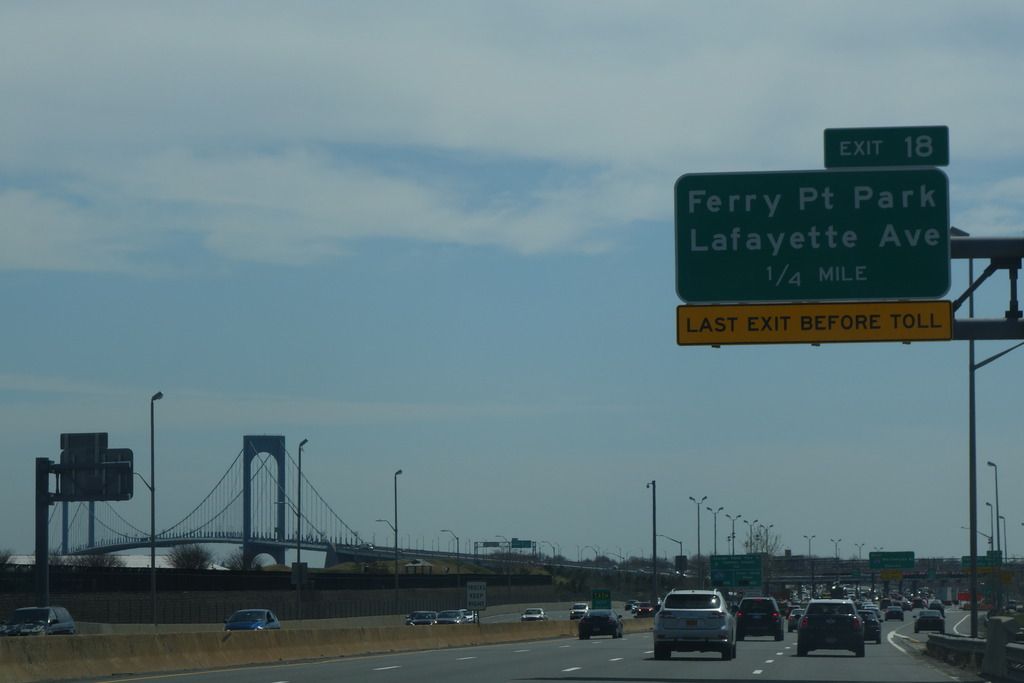
Together with the garish Trump insignia that guards the entrance (it is a Scottish shield, after all), the black cast-iron gate that encircles the entire property might, I fear, be offputting to some and suggest that, despite its truly public status, the course might not be for everyone; a "public welcome" addendum might help:
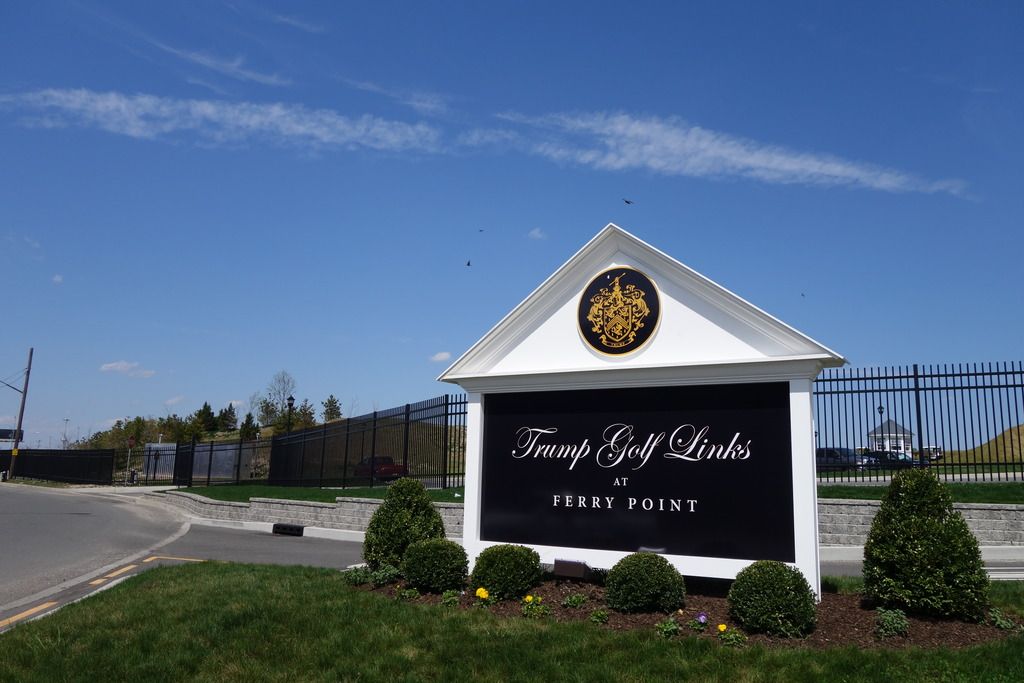
In classic Trump style, the makeshift clubhouse (a larger, hopefully not-too-ostentatious one will be built in the next few years) is not your ordinary trailer; the yellow-and-white theme works wonderfully, especially in the awning-covered grill area on the back, to create a seaside atmosphere:
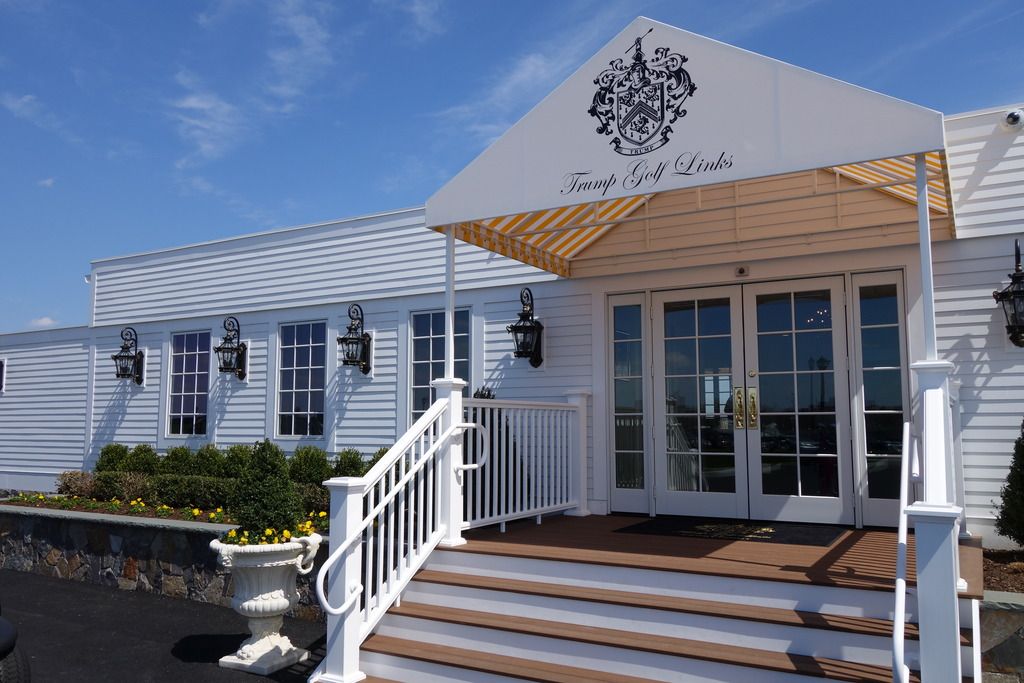
Augmented by stellar service, the food is quite good (the "Ivanka" is one of the better Greek salads I've had):

The view from the open-air grill isn't too shabby, either (to be clear, Trump's courses do not have Rolex clocks; they have Trump clocks):

For a public course, Trump Ferry Point has some of the better practice facilities I've seen; actually, they're better than those at many private courses I've been to. No wonder Michael Breed just opened his academy here. A massive driving range (TaylorMade range balls are provided free of charge) is the main attraction, but adjacent short-game and putting areas allow the golfer to fine tune all aspects of her or his game before teeing off:
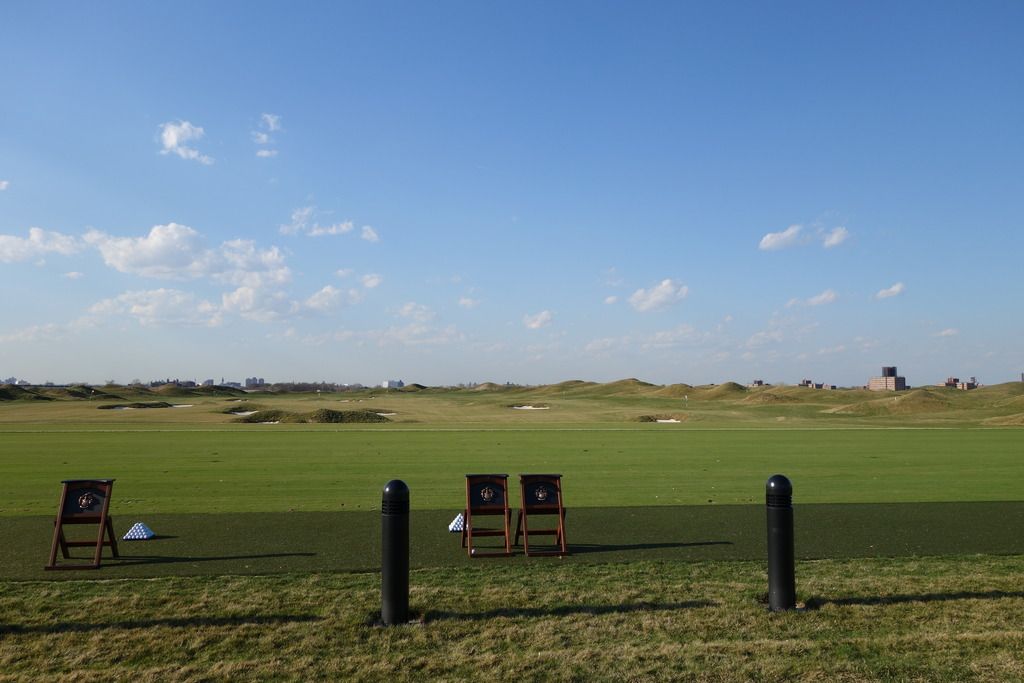
The Throgs Neck Bridge, the less-prominent of the two bridges visible from many points on the property, frames the background of the short-game practice area:
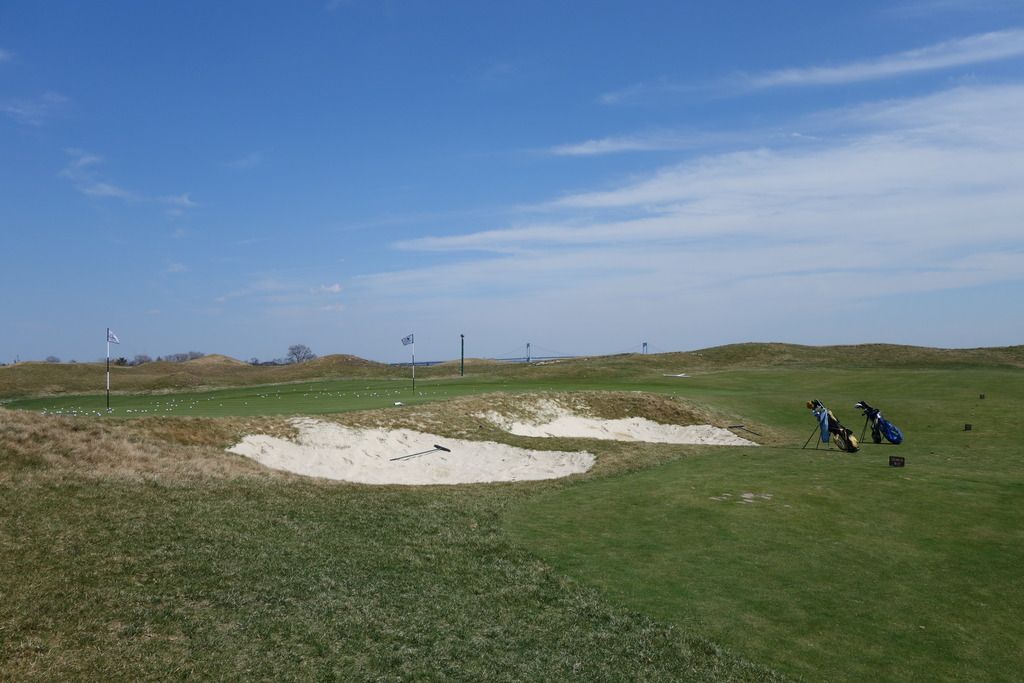
The large putting green affords wonderful views of both bridges:
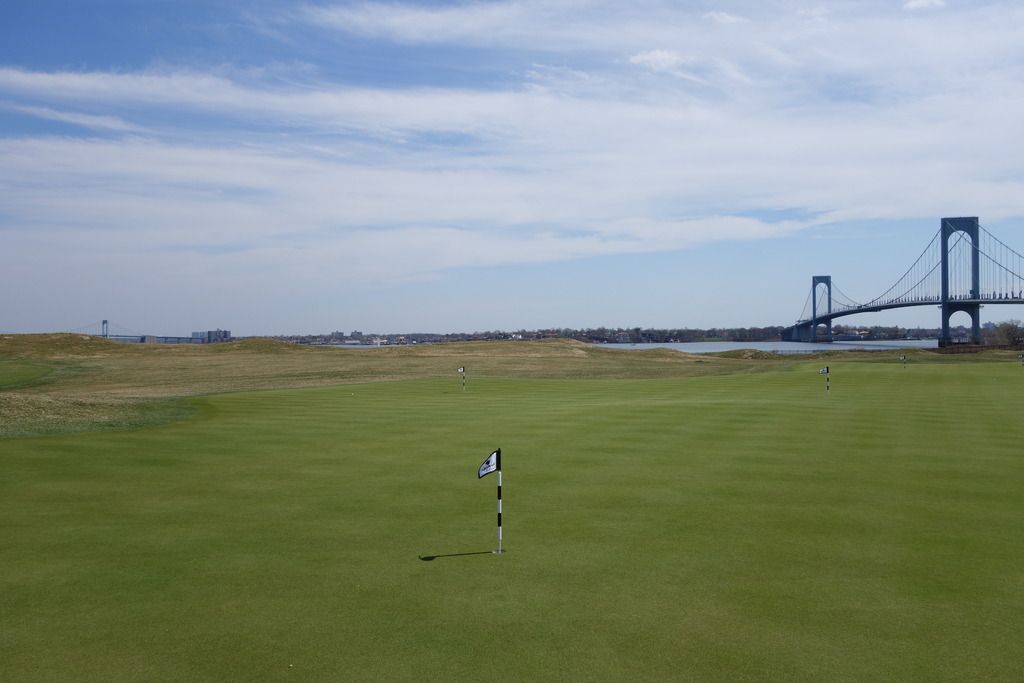
The routing, and place mats, at Ferry Point:
 Front Nine
Front NineThe 1st, a steadily climbing and narrowing par 4, has just enough trouble off the tee--specifically, the (not pictured) highway up the left side--to demand the golfer's full attention; once in the fairway, the fairway rises at the same rate, and gives the golfer a similar feeling, as the first at Streamsong Blue:
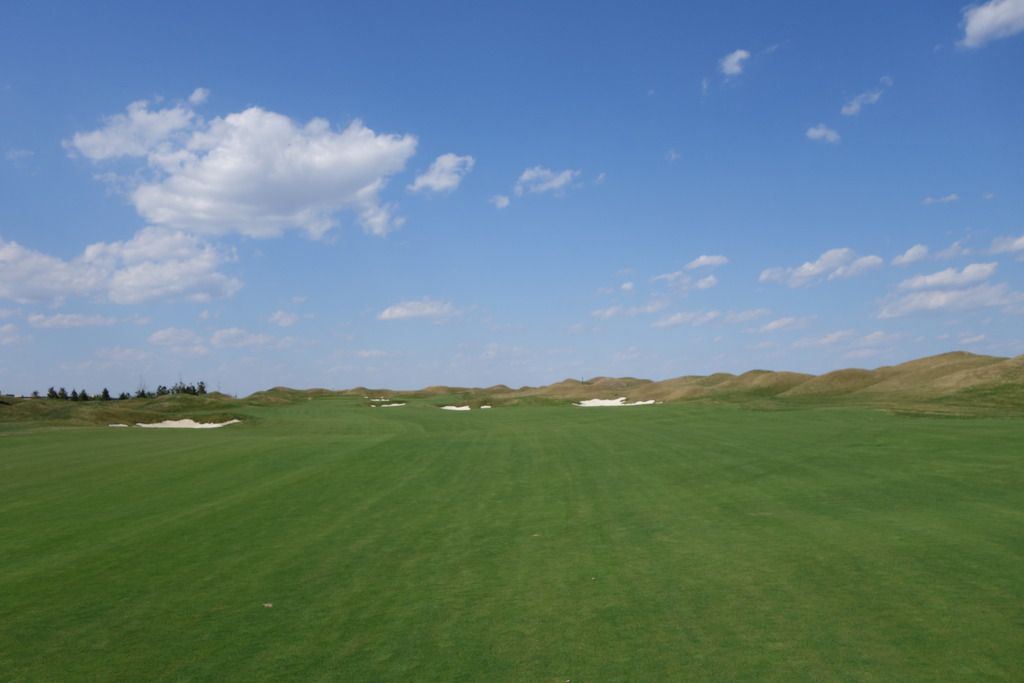
A recent Jack Nicklaus staple--the centerline bunker--makes its first of many appearances at Ferry Point on the very first hole, although it is too far from the tee, well past left and right fairway bunkers, to serve as anything other than a visual hazard:
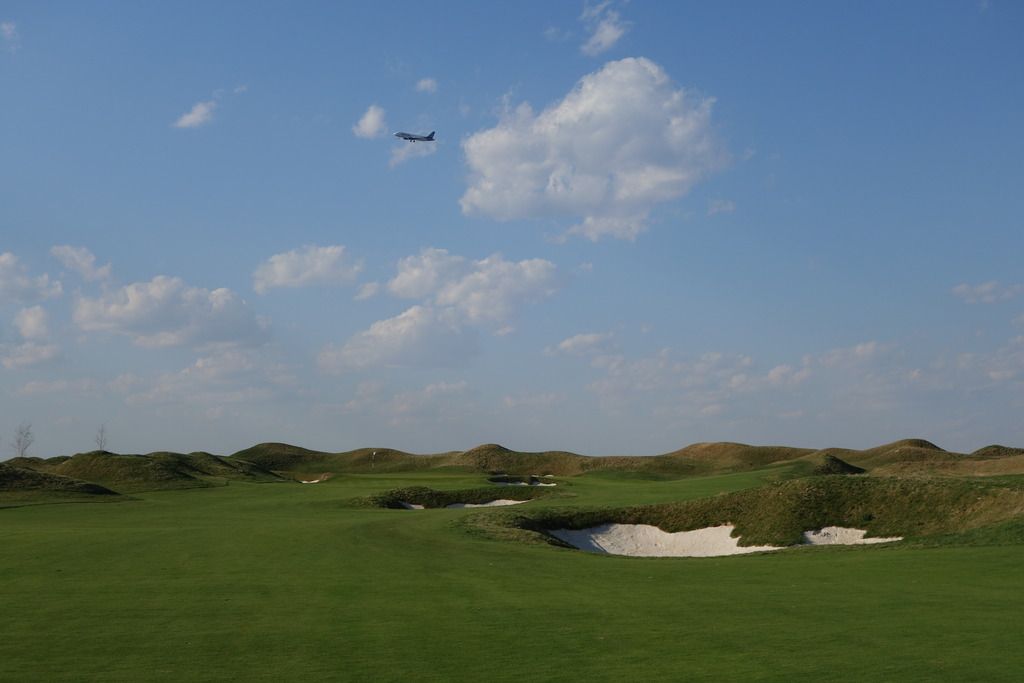
One of many attractive, dune-nestled green sites at Ferry Point is also found at the 1st:
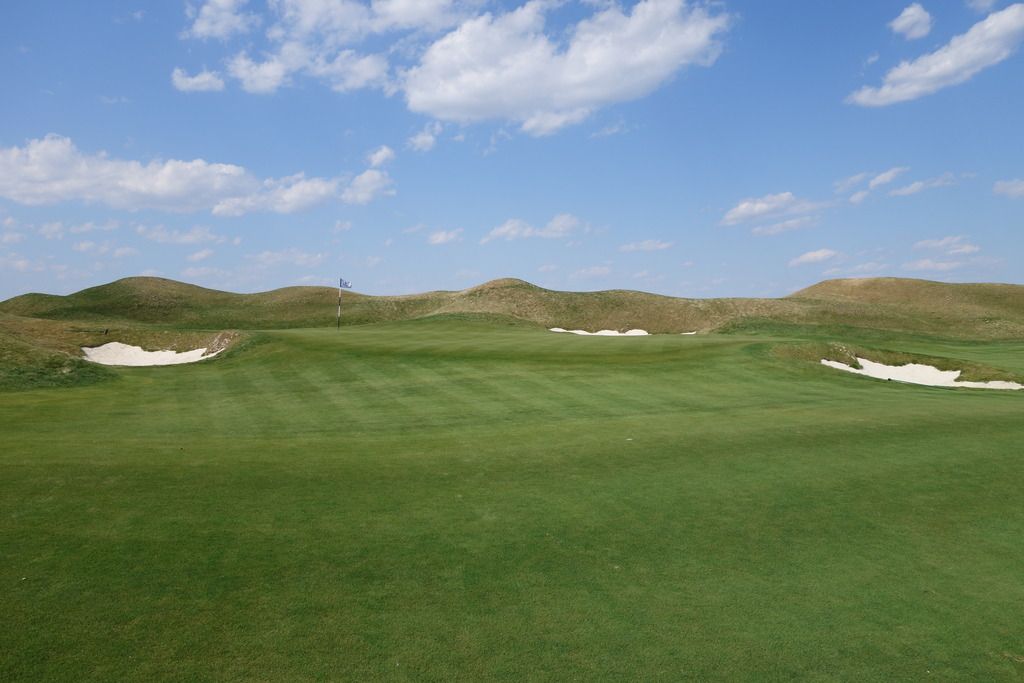
The view back down the 1st hole showcases both the Whitestone (right) and Throgs Neck (left) bridges:
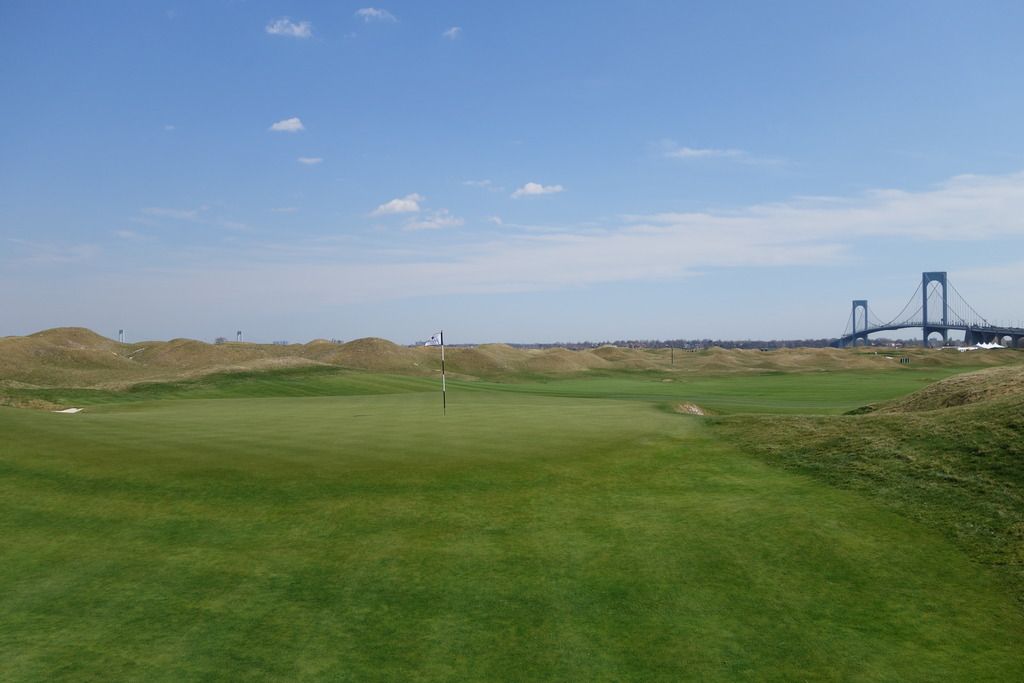
The second-longest green-to-tee walk (after 9 green to 10 tee) brings the golfer to the 2nd tee and the first view of the expansive, rumpled area that occupies the heart of the course:

Looking off to the right of the 2nd fairway reveals two features that dominate the landscape at Ferry Point--man-made dunes/mounds and the Whitestone Bridge:

The nestling of green sites into large dunes continues at the 2nd, a large back-right to front-left green that sits diagonally to the fairway; given the hole's length, Nicklaus properly built a large chipping area short right, where most golfers will miss:
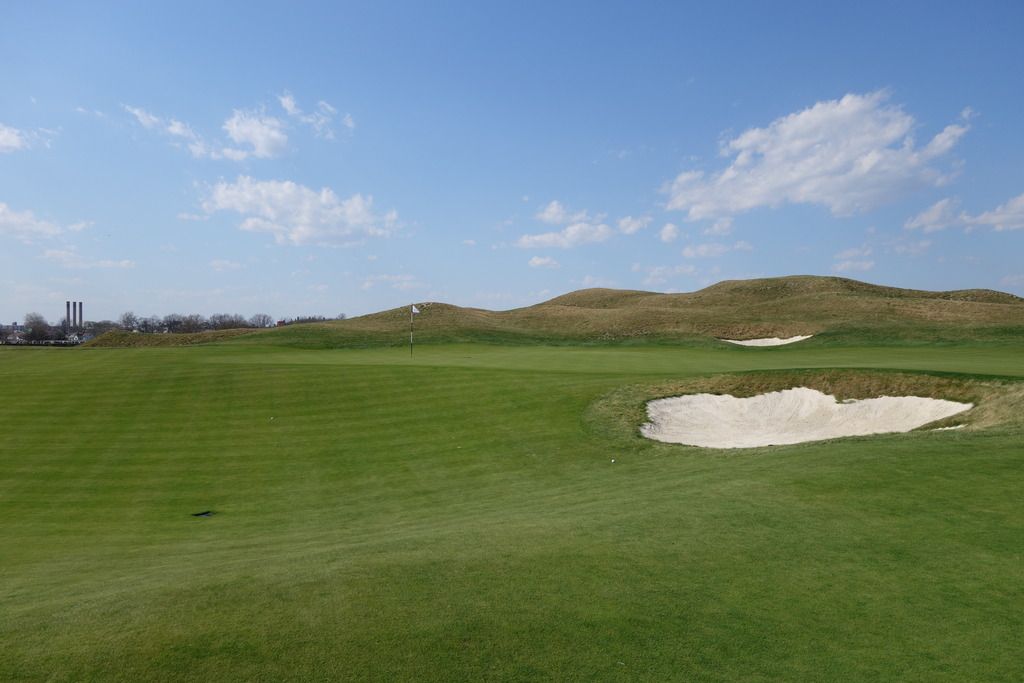
The view left over the 2nd green features many industrial landmarks that not only scream New York City, but also recall the gritty surrounds of some of the great links of Great Britain (think the nuclear towers that, until recently, lorded over Royal St. George's):
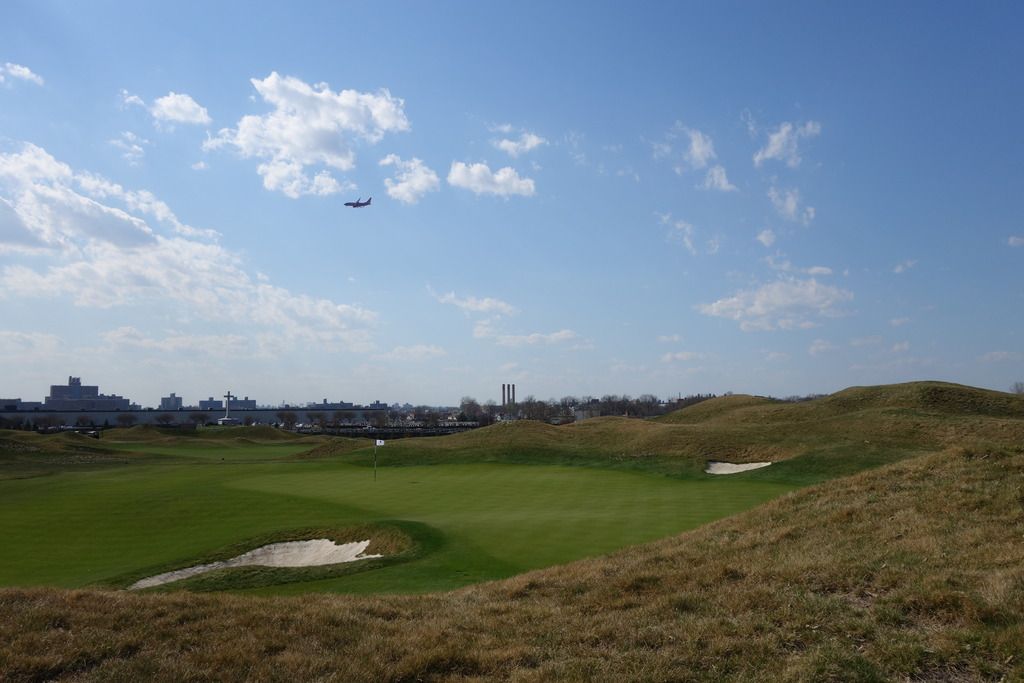
Each of the par 3s runs in a different direction; the 3rd, the second longest, is framed beautifully by the red-brick housing projects that dominate the north-facing views at Ferry Point; note the visual mimicry between the large mounds/dunes and the buildings themselves:

The 4th, an attractive gently climbing three-shot par 5 at the northern edge of the property (though seemingly reachable on the scorecard, it plays into the prevailing wind), is defined as much by its gorgeous views of the Throgs Neck Bridge (the golfer never gets closer to it), as by its devilish perched green:
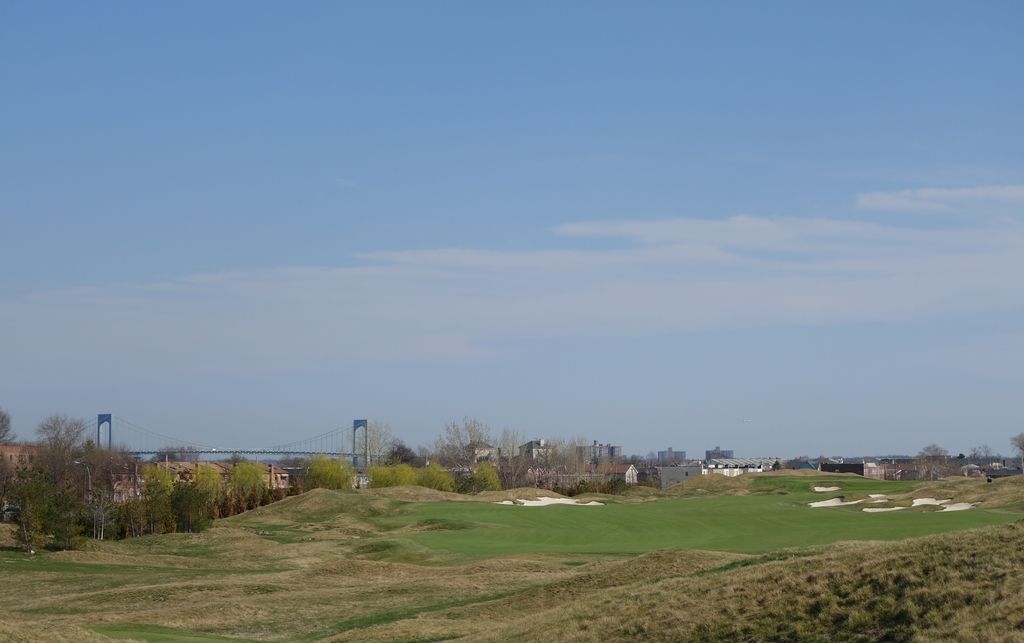
Accounting for the into-the-wind nature of the shot, the layup area on the par-5 4th is ample:
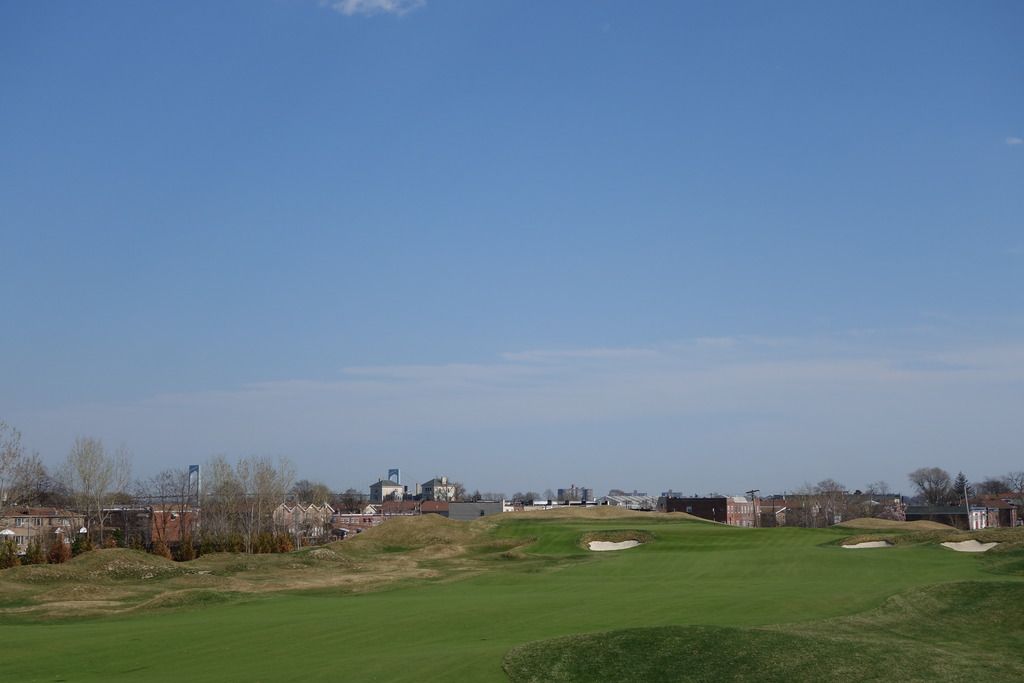
The narrowness of the 4th green is accentuated by steep falloffs all around--here, at the front:
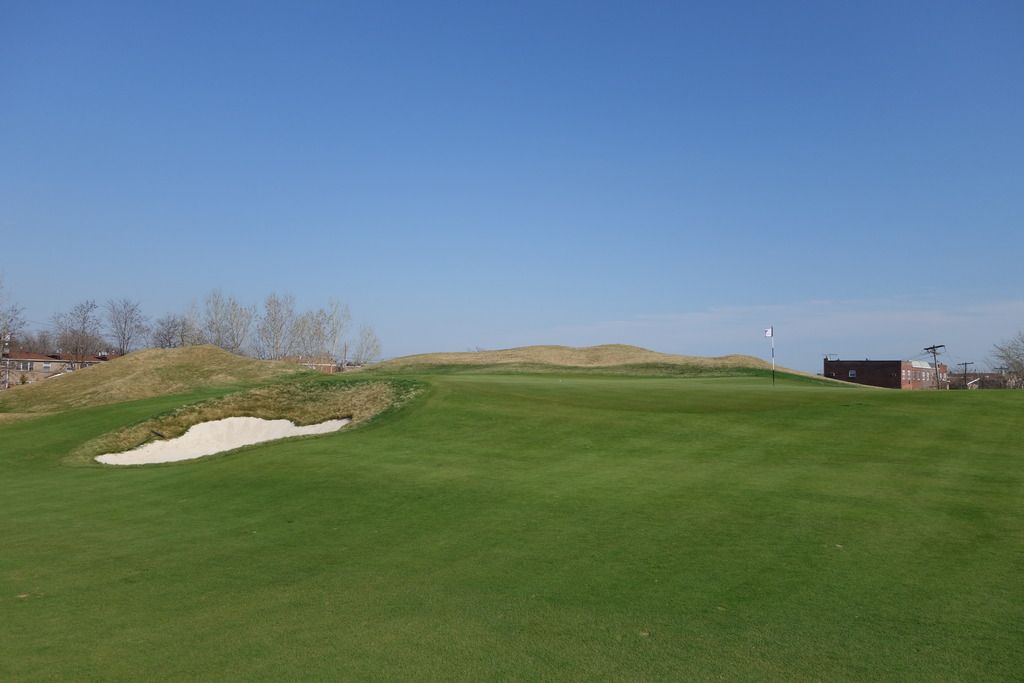
Here, at the back:

And, finally, here, at the right:

On first playing, the direction of the 5th, one of the few doglegs at Ferry Point, is not apparent from the tee; the turn to the right comes into view two hundred yards down the fairway and reveals another attractive perched green site surrounded by gum-drop mounds:
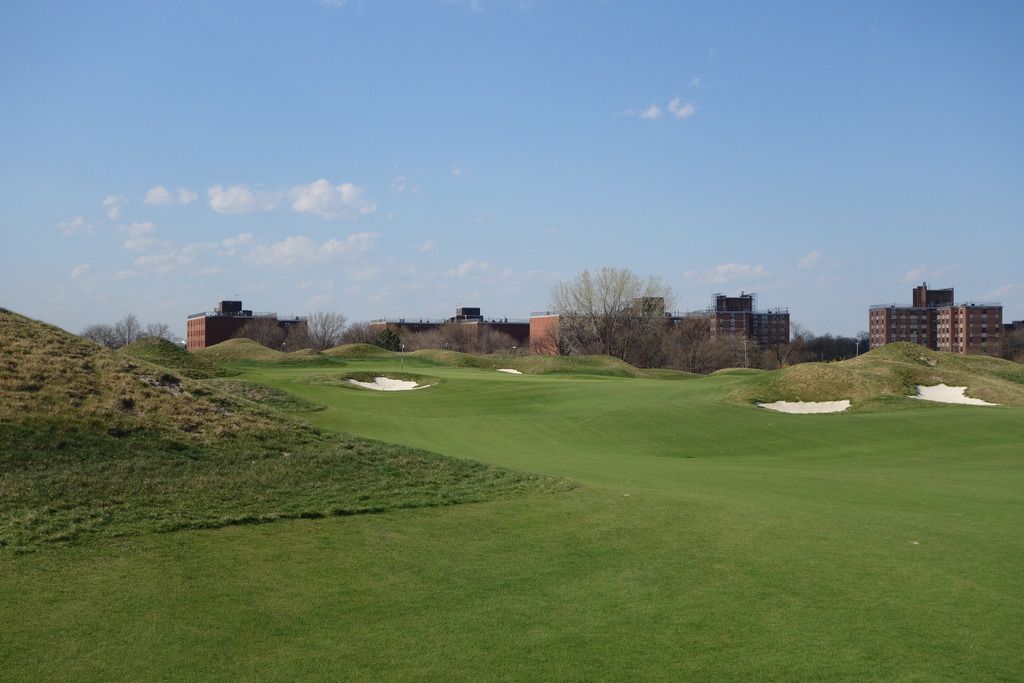
The reverse view from behind the 5th green reveals the dogleg-right orientation of the hole; the tee is next to the snack hut in the distance on the left (currently, the snack hut is the only place to get water on the course, but the course's manager promised water jugs throughout in the very near future):

A strategic double-dogleg par 4--the tee shot plays left to right uphill, while the approach plays right to left downhill--the 6th hole affords the first direct view of the silhouetted Manhattan skyline to the south:
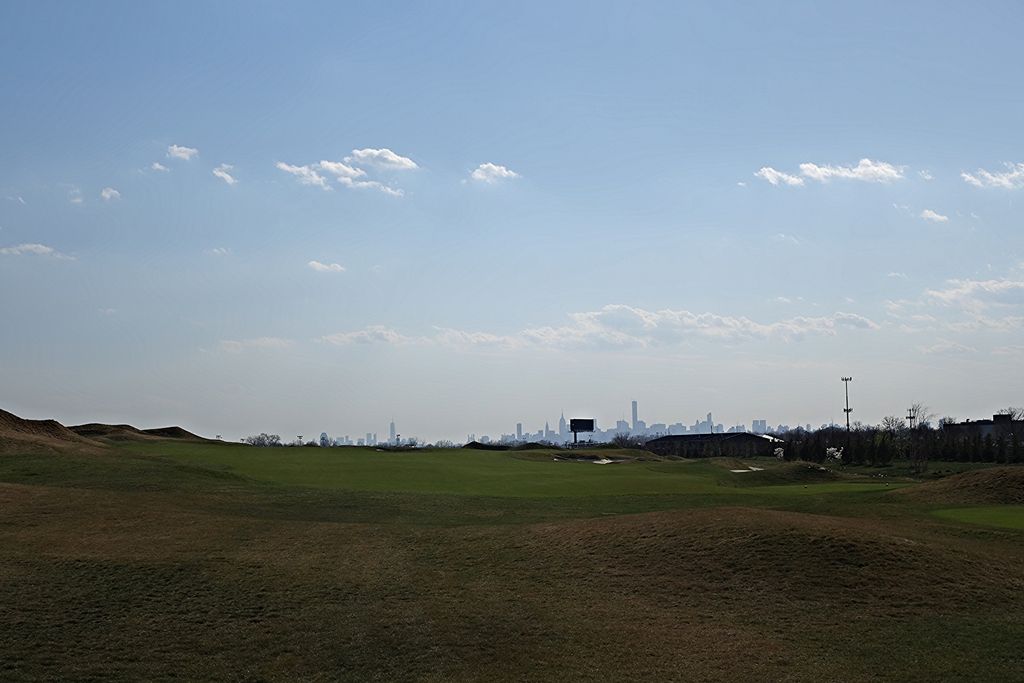
The aggressive line off the tee, and the one affording the better view of the green around the corner to the left, is to the right of the centerline bunker (out of bounds, and a cemetery, lines the right side of the hole):

The safe line left of the centerline bunker affords beautiful views of the Whitestone Bridge...
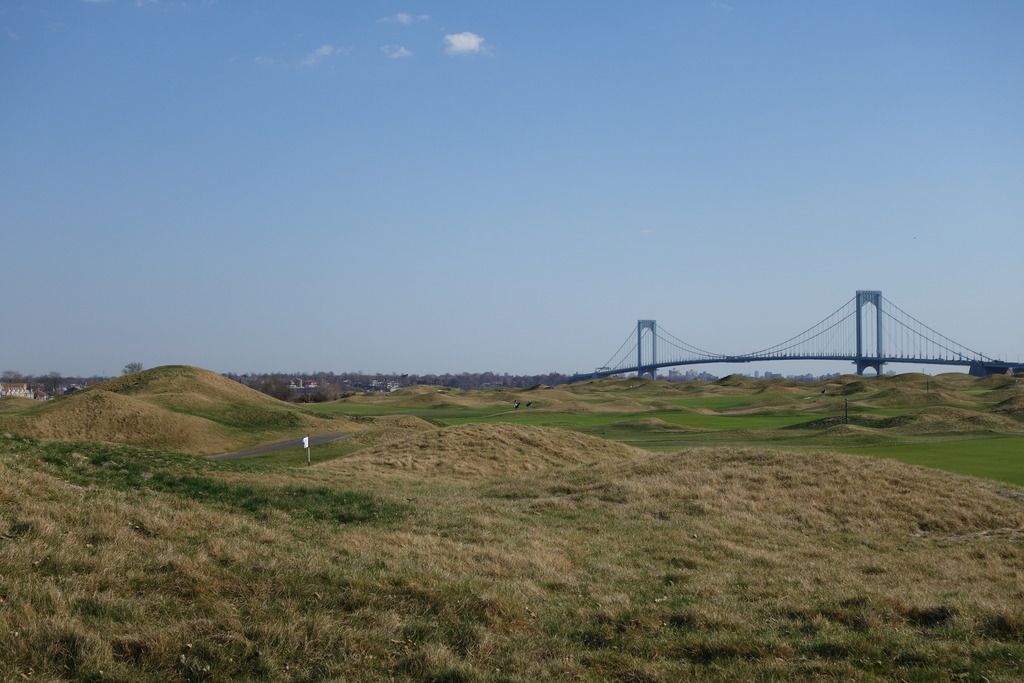
...but leaves this partially obscured view of the green:
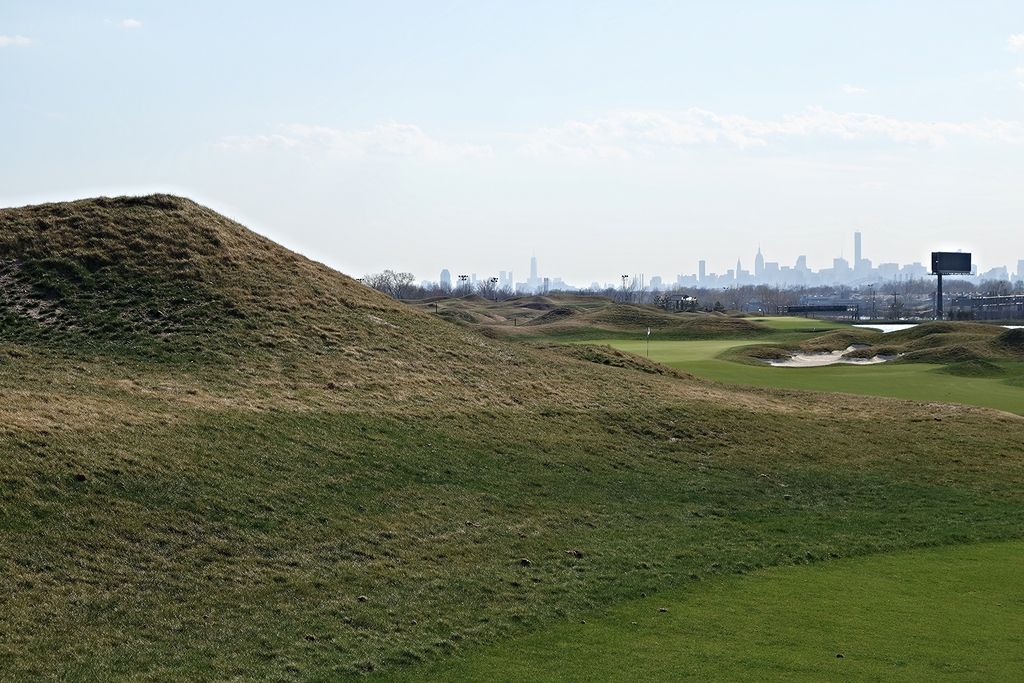
The right-to-left downhill nature of the approach at 6 is evident from this reverse view from back right of the green:
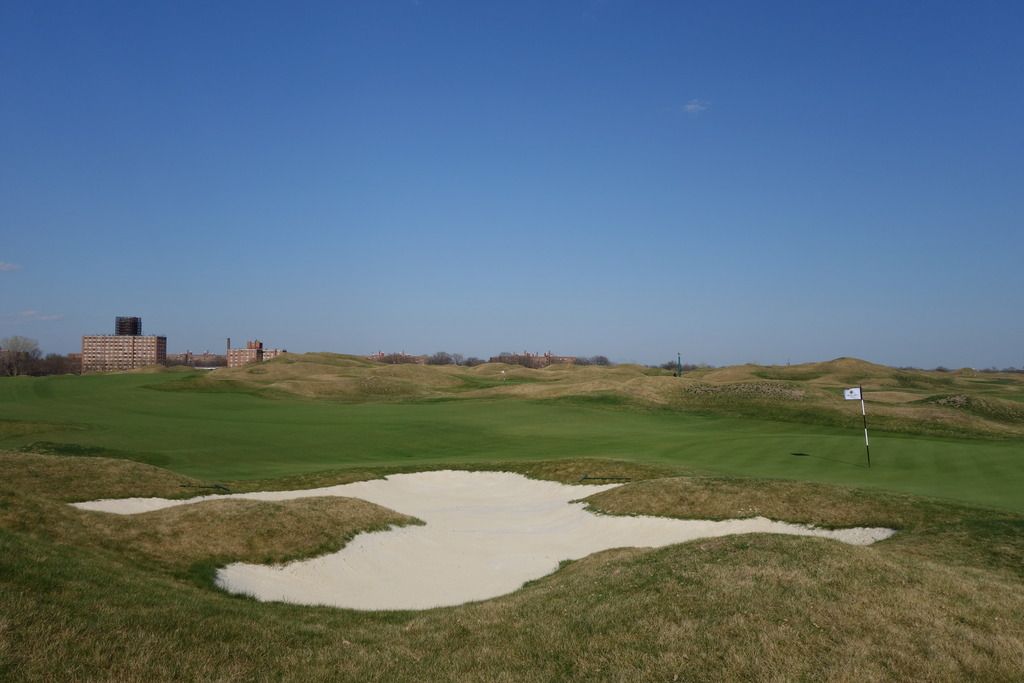
An excellent short and drivable Cape hole, the 7th calls for a fade from the tee--at once helped and hindered by the prevailing left-to-right wind:
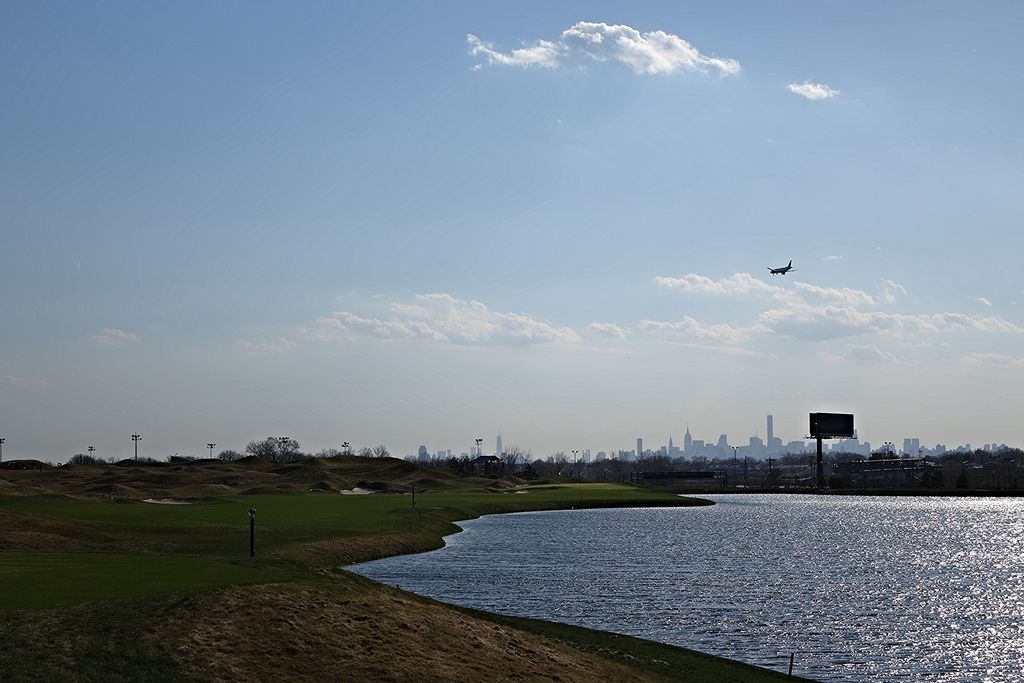
A sprawling bunker complex guards the final 20 yards of the left side of the fairway all the way to the green:
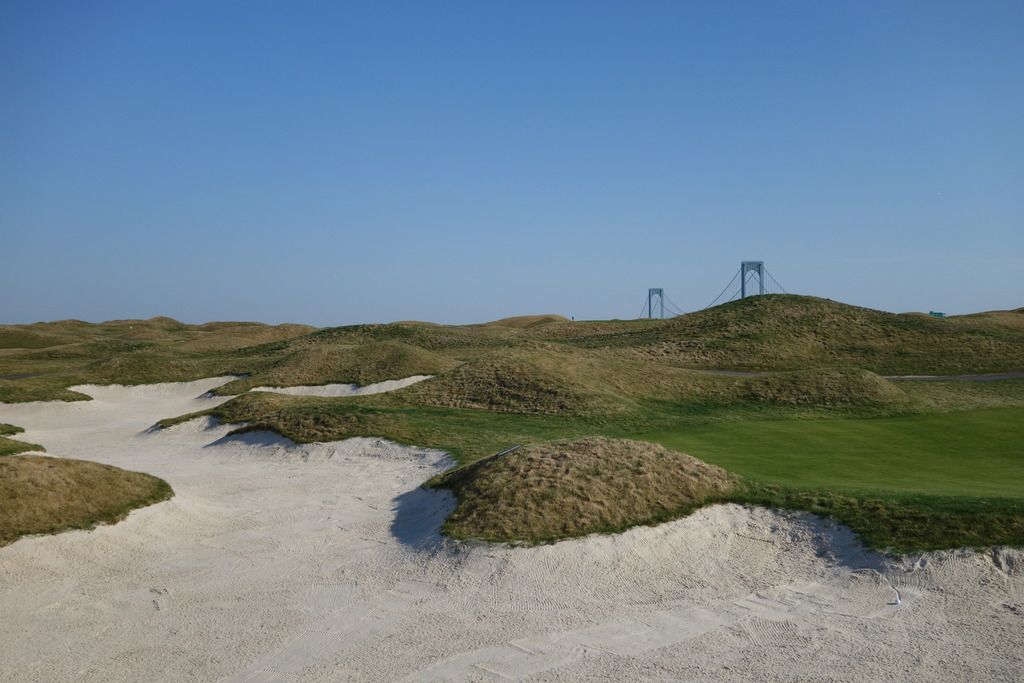
This reverse view of the 7th reveals that a long miss is actually a safe one:
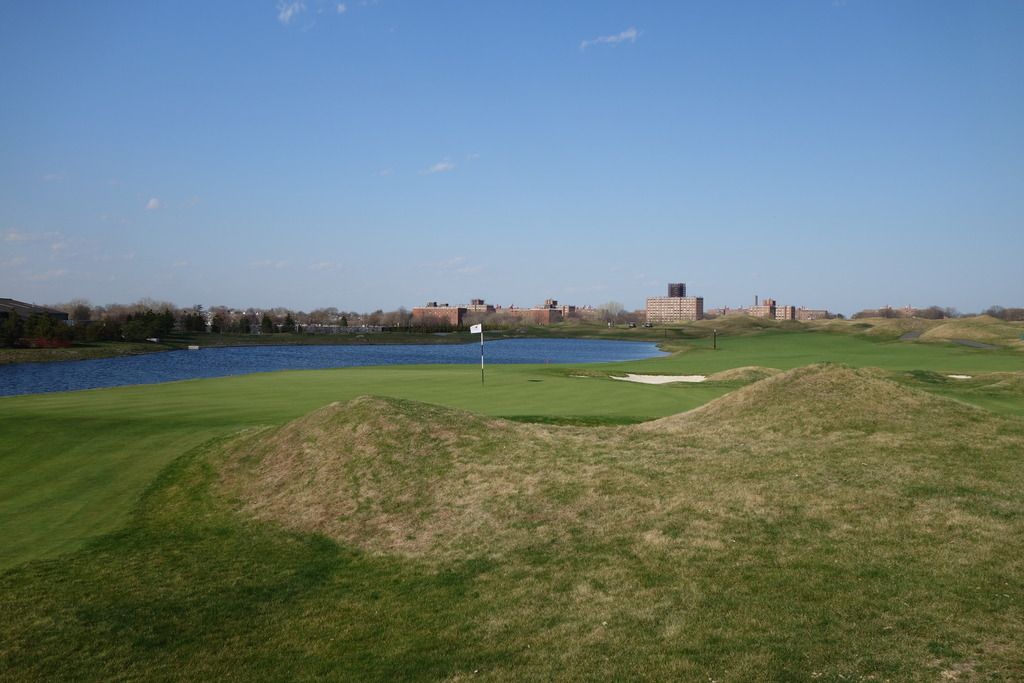
The second par 3 at Ferry Point, the 8th, plays slightly downhill to the north and is surrounded on all sides by mounds and dunes, with the Throgs Neck Bridge in the distance; the setting reminded me somewhat of the glorious 13th at Barnbougle Dunes:
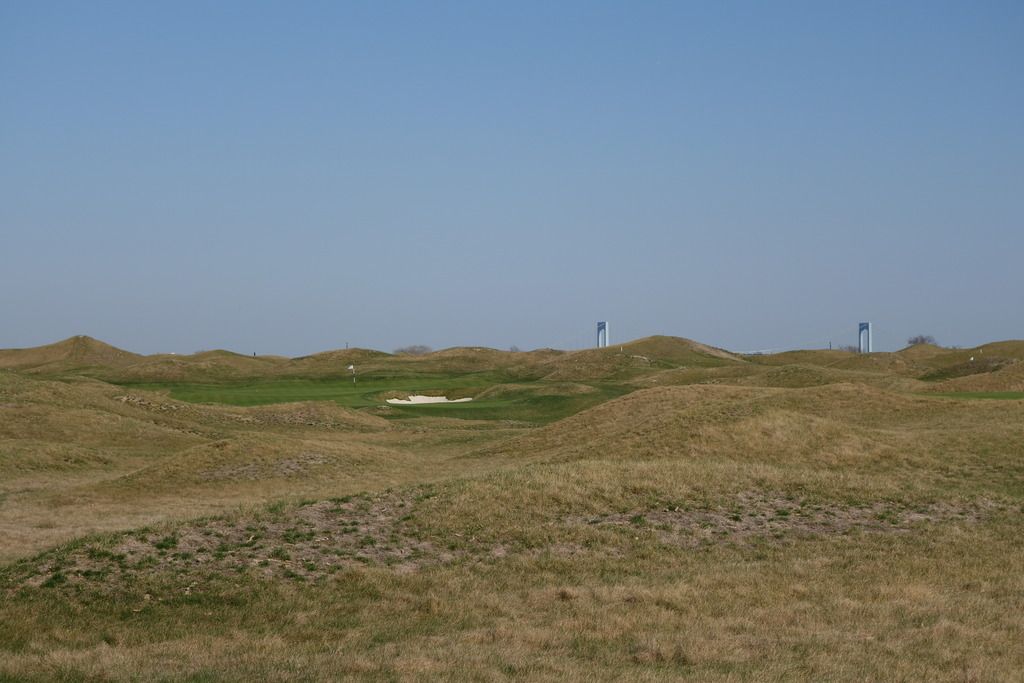
The setting for the 8th green becomes more appealing as the golfer walks through the depression between the tee and the green:
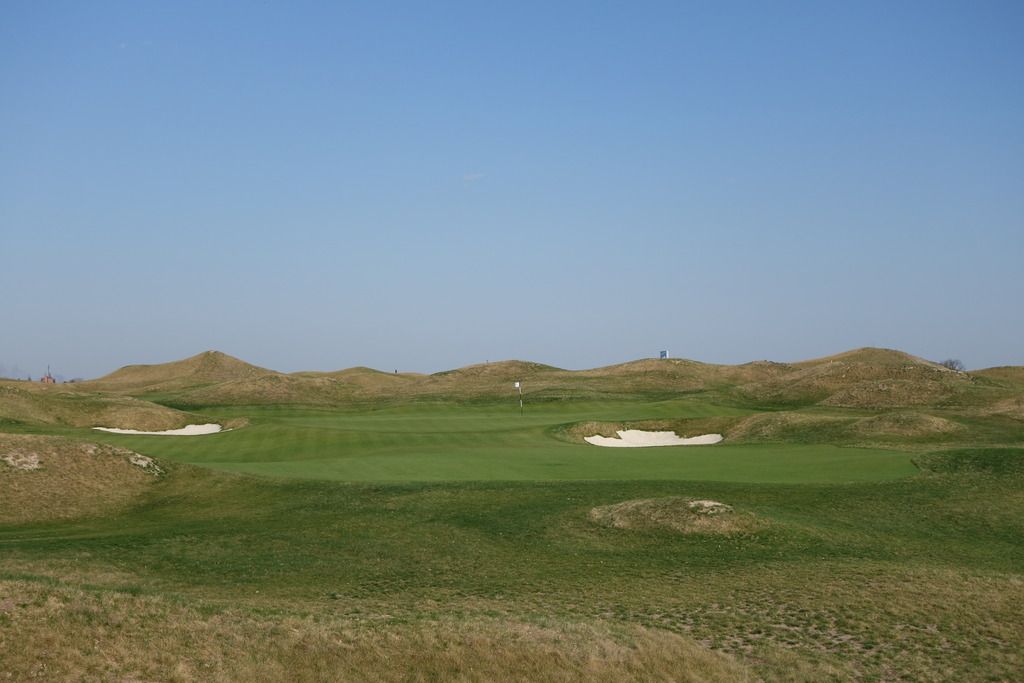
The most beautiful tee shot on the course, with another centerline bunker to navigate, the 9th plays downhill and slightly to the left toward the Whitestone Bridge (thank you for indulging my penchant for black-and-white pictures):
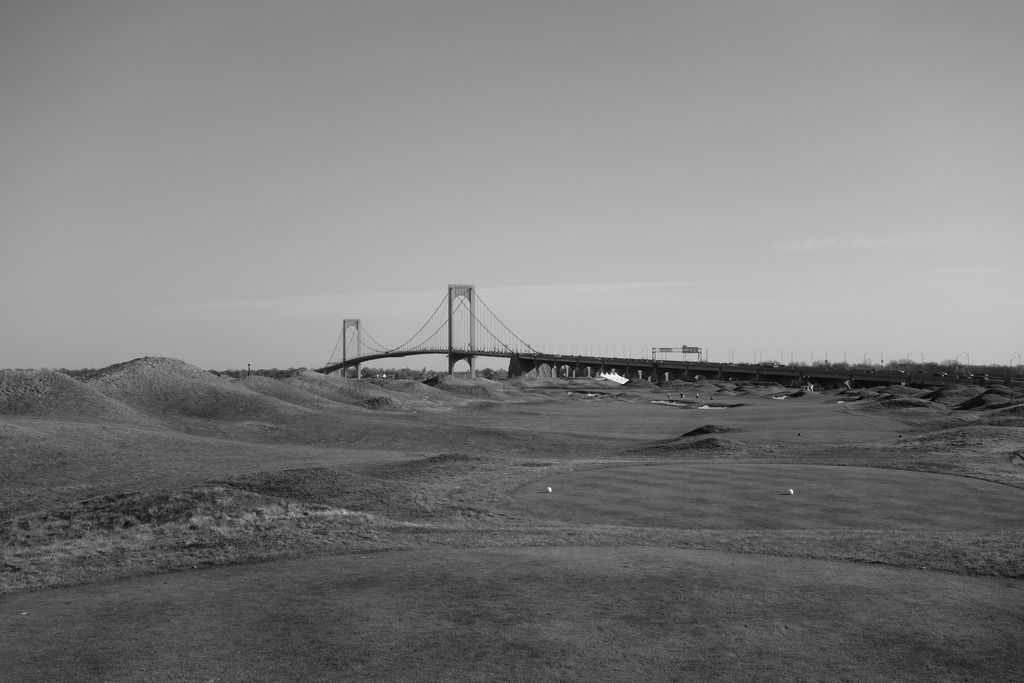
A tee shot down the right side, or even in the right rough, rewards the golfer with an open view of the green:

Conversely, a tee shot down the left side leaves an approach dotted with obstacles:
